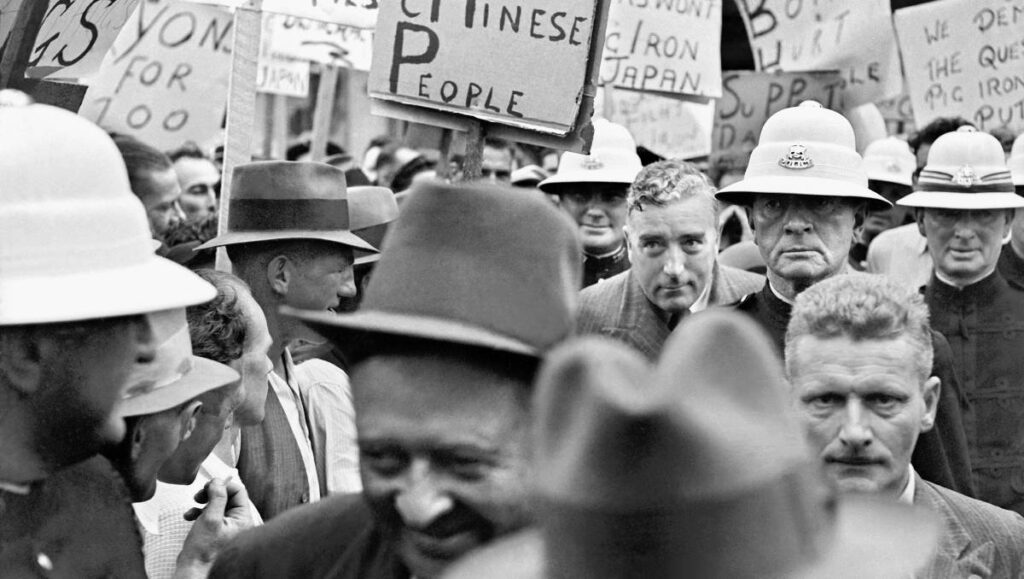On this day, 11 January 1939, Robert Menzies visits the Illawarra to personally meet with Port Kembla’s striking waterside workers during an episode which would earn him the scornful epithet ‘Pig-Iron Bob’. The issue in dispute was the loading of pig-iron onto the steamer Dalfram bound for Japan, an act which the workers refused to carry out on the grounds that Japan was already showing her imperialist ambitions by invading China and seemed likely to turn on Australia. Although this is generally viewed as a low point in Menzies’s career, his visit was an act of significant personal bravery in fronting up to an incredibly large and hostile crowd.
The strike was organised by Waterside Workers’ Federation South Coast Branch Secretary Tom Roach. It followed a series of ‘No Scrap for the Jap’ demonstrations that had been occurring on wharves since September 1937, however these had not previously escalated because of fears the Government might invoke the Transport Workers’ Act of 1929, known as the ‘dog collar act’ for its draconian provisions. Roach was bolder than some of his counterparts, and appeared unperturbed by the threat this Act posed. He explained that the strike was explicitly political rather than industrial in its goals, arguing that ‘success to the Japanese Fascist Militarists in China will according to their own statements inspire them to further attacks on peaceful people which will include Australia’.
The Lyons Government had already banned the export of iron ore due to the precarious international situation and a desire to preserve limited resources (Australia’s largest deposits of iron had not yet been discovered), and no public explanation had been given as to why this ban had not been extended to pig-iron. The Government may have privately considered extending a universal ban, but what it was not prepared to do was impose unilateral sanctions specifically targeted at Japan and risk provoking her without any backing from the international community. Likewise, the Cabinet was not going to let an individual union branch dictate Australia’s foreign relations. It is worth noting that Opposition Leader John Curtin remained largely silent during the dispute, and he is reported to have told Roach ‘If we were the Government, you would still have to load pig-iron’ based on the same reasoning as that put forward by the Lyons Ministry.
As Minister for Industry Menzies carried the responsibility for handling the dispute on behalf of the Government. He explained that ‘the issue at stake is not whether the waterside workers are right or wrong in their view on what the international policy of Australia should be’ but whether that policy should be determined by the ‘duly constituted Government of the country or by some industrial section’. Under the direction of Cabinet, he threatened the strikers to back down or he would invoke the Transport Workers’ Act allowing the recruitment of strike-breakers.
This threat failed to achieve its purpose, as the workers had their resolve reinforced by a significant outpouring of community support. Even the UAP-leaning Sydney Morning Herald reported that people were ‘bewildered by the apparent contradiction’ in banning the export of the mineral but not the processed pig-iron.
By late December 1938 the strike was threating to shut down the BHP steelworks and take 5000 jobs. In these circumstances an exasperated Menzies tried to further elaborate the reasoning behind Government’s position:
‘Is it seriously thought to be either prudent or desirable that of the fifty-odd nations in the League of Nations, Australia should be the only one to adopt such a course? And if this course is to be pursued in relation to pig-iron, which may provide materials for munitions, must it not also be applied to wheat and wool, seeing that food and clothing are as essential an element in military operations as guns and ammunitions?’
In January he accepted an invitation from Port Kembla’s Federal MP, Labor’s Bert Lazarrini, to visit Wollongong and meet the strike leaders. People flooded into the city, holding placards and booing as Menzies drove down Bulli Pass under a police escort. At Corrimal a large banner stretched across the road reading ‘The People of the South Coast Fully Support the Wharfies in the Pig-Iron Struggle’. Menzies had lunch with the Mayor at the Wollongong Hotel, then had to cross the road to a meeting at the Town Hall, a precarious situation in which an escort of union members had to guard Menzies from the immense crowd, all the while ‘he was abused by everyone, including women and children’.
No compromise was reached on the day, but by 21 January the workers returned to work and loaded the pig-iron, having accepted a government promise that it would not invoke the ‘dog collar act’ and that it would engage in serious discussion about future pig-iron exports. The Government had won its point of principle, but the strikers had successfully drawn an incredible amount of attention to the issue and proven that the ‘dog collar act’ could be overcome through political pressure. The limited victory also came at great political cost, particularly for Menzies.
Further Reading:
A.W. Martin, Robert Menzies, A Life: Volume 1 1894-1943 (Melbourne University Press, 1993).
Greg Mallory, ‘The 1938 Dalfram Pig-iron Dispute and Wharfies Leader, Ted Roach’, The Hummer Vol. 3, No. 2 – Winter 1999.
Sign up to our newsletter
Sign up for our monthly newsletter to hear the latest news and receive information about upcoming events.


